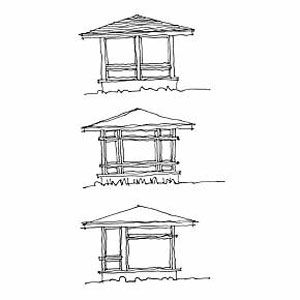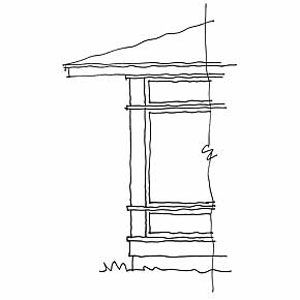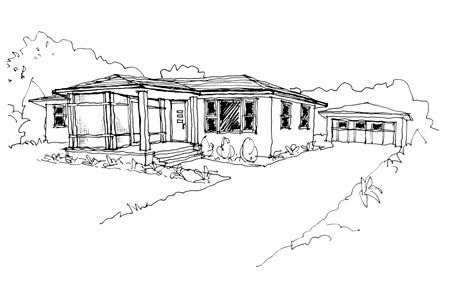
Question:
I want to add a screened porch to my 1960s rambler. What are the basic design elements to consider so that it looks good and works well?
Answer:
I grew up in a house with a screened porch, and they’re near and dear to my heart. I’m pleased that you’re willing to invest in this space. In my part of the world, where winters are long, most of my clients quickly calculate that they will only be able to use a screened porch for half the year, and they succumb to practical, left-brain logic. I suggest throwing out the quantitative calculations and instead imagining the invigorating day in early spring when the French doors from the house are thrown open and the smells and sounds of the outdoors come swaggering in with the freshness of the new season.
Now that you know how I feel about screened porches, we can talk about the elements to consider when adding one to your home.
LIVENING UP THE FACADE1. Site Orientation
The first and most basic consideration is the site and its orientation to the sun. Will the porch be located to the south, so that it gets early- and late-season warmth? Or is it on the north side of the house, making it a cool refuge from summer swelter? Think also about what surrounds the house: Which views and sounds would you like to capture? Do you want a quiet retreat in the garden, or a social gathering place? A porch on the front of the house will feel far more public than one tucked in the back, which can be an asset or a liability, depending on what you expect from this outdoor living room.
EXTENDING THE ROOFLINE2. Rooflines
If you want to create a seamless addition to the house that looks like it has always been there, start with the roof. The long, low-pitched roofs of the rambler grew out of the Prairie style. These linear houses pay homage to the horizon, something to keep in mind if your intent is to maintain the rambler aesthetic. The good news is that the simple roof of a rambler makes adding on easy. One approach is to match the existing roof pitch and style and the length of the overhang and the fascia boards. But a new porch can also be an ideal opportunity to add a little zip to an otherwise uneventful facade. One way to do that is to increase the overhang. As the overhang gets longer, the roof seems to be stretching out to the horizon. It will take on a hovering character, with some attitude that will distinguish your rambler from the others on the street.
THE VIEW FROM INSIDE

Question for an architect, continued
3. Circulation
A clear path to the screened porch and good circulation within it will make it live well. The answer to the question of circulation begins with the question of use. Is it a place to eat or a place to relax? What kind of furniture do you envision and how will it be arranged? How does the porch connect to the outside? The porch is often a transition space between outside and in. Design the room so that doors have a place to land and circulation does not need to cut through the conversation group/living space.
4. Materials
The materials you choose will determine whether your porch feels like a part of the house or an extension of the garden. For example, if the wall that abuts the house has exterior siding and the floor has the same flagstone as on the patio outside, it will tend toward the outdoors. By contrast, exterior-grade cove molding and base trim, along with a more refined finish on the floor, will give the space an interior feeling. In either case, look to the existing materials, colors, and details of your rambler and either match them or design a variation that complements the original house.
SCREEN PANEL DETAIL5. Screen Walls
The columns of the porch are a primary part of its style, and it’s important not to undersize them visually. Whether simple heavy timber, tapered Craftsman, or clean modern, they should look good with the existing house. A well-designed screen wall is put together so that there are visual layers to it. If the columns, frame, and screen panels are all in the same plane, the porch runs the risk of looking dull and flat. However, when the columns are the most prominent, with the frame stepped back and the screen panels set within, the shadow lines give it a sense of depth and heft that makes it look integral to the house rather than tacked on.
6. Amenities
Consider adding unexpected elements to your screened porch, like a fireplace or a potbelly stove to extend the season. A built-in grill makes the room a bona fide open-air
kitchen and dining room. Ceiling fans can add a breeze when the weather isn’t accomodating, and a built-in bookshelf could be filled with summer reading. Speakers in the ceiling seamlessly add music or the ball game in the background. Incorporate elements from the favorite porches in your past: A bench swing or a hammock encourages even the busiest of people to stop for a moment and savor the season.
Got a Question for an Architect?
Each month in this column, an architect will answer a reader’s home-design query. If you want advice on anything from how to site your addition to the best layout for a mudroom to choosing the right windows for your space, send your question, along with copies of photographs or floor plans, to House Calls, This Old House magazine, 1185 Avenue of the Americas, 27th Floor, New York, NY 10036. If your question is selected, the answer will appear in an upcoming issue. Due to the volume of mail, we cannot answer unpublished questions.

